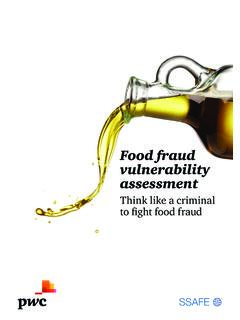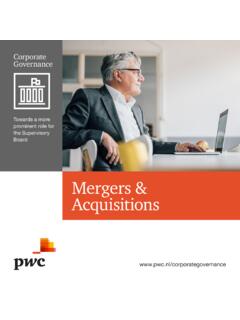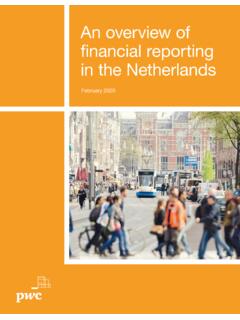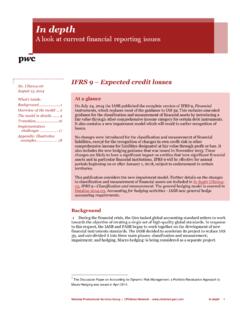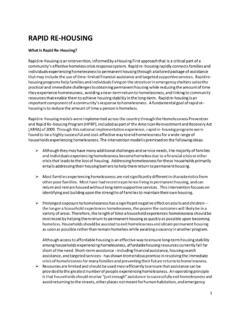Transcription of Supplier Relationship Management - PwC
1 Supplier Relationship ManagementHow key suppliers drive your company s competitive advantageAt PwC in the Netherlands over 4,600 people work together from 12 offices and three different perspectives: Assurance, Tax & HRS and Advisory. We provide industry-focused services and search for surprising solutions, not only for national and international companies but also for public sector and civil-society firms provide industry-focused assurance, tax and advisory services to enhance value for their clients. More than 169,000 people in 158 countries in firms across the PwC network share their thinking, experience and solutions to develop fresh perspectives and practical all self -respecting procurement organisations have a stated intent and commitment to do more in the area of Supplier Relationship Management .
2 And for all the right reasons: Without SRM, negotiated savings may never be realised, The business might consider procurement missing in action when something goes wrong, and Suppliers may begin to see procurement as just negotiating, not involved in the real business. As a result, they might not make their best effort going forward, let alone be proactive in offering innovative call to do more with SRM is not new, so isn t it about time we actually started doing more and talking less? The answer is yes, but the process is not easy and some help and input on the following could be valuable: The capabilities and composition of the procurement team might need to change, The team s orientation may need to be adapted (with a view to primarily selling the company to suppliers to get the best inputs first), Time allocation could need tweaking ( , spending more time with suppliers than with the procurement team), and Roles and engagement with internal stakeholders might need a review (essentially, inserting procurement into a business-centric Relationship ).
3 Put simply, being able to negotiate a deal does not mean a buyer is able to manage a Relationship , nor is it possible to ensure premium access to suppliers in a contract. So our team and our toolkit need initiated a study to gain a better understanding of SRM and to advise our clients on this topic. The value of this study for procurement leaders is many-fold: It informs our understanding of what is keeping us from doing more in the area of SRM, It offers practical perspectives and insights that can enhance our action planning, Because the study is based on discussions with our peers, expert interviews and a online survey, it is not theory centric or wishful thinking; it is about real-life lessons from the market, Finally, it is part of our team s ongoing effort to help improving SRM practices with insight and practical , our efforts will not end with this report.
4 On the contrary, our work has just begun. There are lots of opportunities to join the discussion in upcoming roundtables and further practice development. Do let us know if you would like to get involved and benefit from the process. The time is ripe for procurement to start doing what it has been meant to do more for a long time. Please use the advice, experience and tools captured in this report to your advantage. It is our hope that this will help you on your SRM van HoekGlobal Procurement Director PwC & Visiting Professor Cranfield School of Management34 Table of contentsExecutive summary 6 Introduction 71. Key research findings 102. Towards world-class SRM 183.
5 How to establish SRM 36 Acknowledgements 38 About the research team 39 Appendix 1: Population profile of online survey 41 Appendix 2: Detailed SRM maturity model 425 Executive summaryEnsuring the best prices through strategic sourcing is no longer perceived as a strategic capability of the procurement function. As a result of further outsourcing of non-core competencies, organisations are starting to realise that they have become more reliant on suppliers in terms of innovative power, security of supply, corporate social responsibility, and on-going cost savings. Strategic partnerships are at the top of the corporate agenda of many global organisations and Supplier Relationship Management (SRM) is seen as one of the few remaining procurement topics that can still make a significant difference.
6 But many organisations encounter difficulties in initiating, developing and managing partnerships. In particular, leadership and soft skills are mentioned as primary reasons for failure, alongside technical & functional competencies. We initiated a study on SRM to gain a better understanding of the typical challenges involved and to determine how Supplier capabilities drive competitive Innovation, sustainability, leagility and resilience are seen as the key drivers for SRM value creation. 9. Current SRM programmes already contribute to performance Management and risk exposure reduction. 10. The respondents indicate that there is a positive correlation between the presence of SRM and an increase in market share, responsiveness to market changes, increased return on investment and shortening order fulfilment lead CPO roundtable, desk research, an online survey and expert interviews were input for our research.
7 Below, we summarise the ten key findings of our study report:1. The most important SRM objectives are leveraging Supplier capabilities, delivering cost savings and reducing supply risk exposure. 2. Approximately 60% of the respondents have a formal segmentation process in place, with spend size, product/service importance and risk exposure as the most important segmentation dimensions. 3. While the benefits of SRM are acknowledged, the average SRM maturity level is still low. 4. The top-three challenges respondents encounter are an overemphasis on cost reduction, a lack of specific SRM competences and insufficient alignment between the business, procurement and Supplier . 5. Typical best practices are quantification of benefits and costs (ROI), proactive and two-way performance Management , and documented Supplier strategies per segment.
8 6. Benefits measurement, executive sponsorship and strategic coherence are indicated as the most critical success factors. 7. Technical/functional, relational and developmental competencies must be balanced and continuously becomes strategicThe role of the procurement function is drastically changing in today s challenging world. In the past, procurement was expected to ensure the timely availability of products and services while also being responsible for accurately processing transactions. Economic developments during the 1980s and 1990s prompted companies to recognise the potential contribution of procurement to meeting cost-out targets. Through the implementation of category Management and running strategic sourcing initiatives, procurement was able to rationalise the supply base and consolidate volumes, resulting in price reductions.
9 Global sourcing and outsourcing of non-core activities became popular as well. However, the procurement function was still functionally organised, with little collaboration and alignment with other business functions, which kept the price-orientation alive. During the advent of the Total Cost of Ownership (TCO) concept, organisations started to realise that a change from a functional orientation towards processes optimisation was required, with cross-functional collaboration. As a result, procurement became the responsibility of cross-functional teams while its strategic importance and recognition increased. The procurement function not only contributed to price reductions, but also played a crucial role in optimising total lifecycle costs. The next step towards procurement excellence is to adopt a value-driven orientation with external/ Supplier collaboration as a key stated previously, ensuring the best prices through strategic sourcing is no longer perceived as a strategic capability of the procurement function.
10 As a result of further outsourcing of non-core competencies, the procurement costs as a percentage of total cost is 50-80% for companies that develop, manufacture, trade and/or distribute goods. Besides this financial impact, organisations are starting to realise that they have become more reliant on suppliers in terms of innovative power, security of supply, corporate social responsibility, and delivering on-going cost savings. Together with sustainability, strategic partnering is at the top of the corporate agenda of many global organisations and is seen as one of few remaining procurement topics that can still make a significant integration: next step towards procurement excellenceCompanies are now aware that they must integrate and collaborate with suppliers to remain competitive and take the next step towards procurement excellence.
